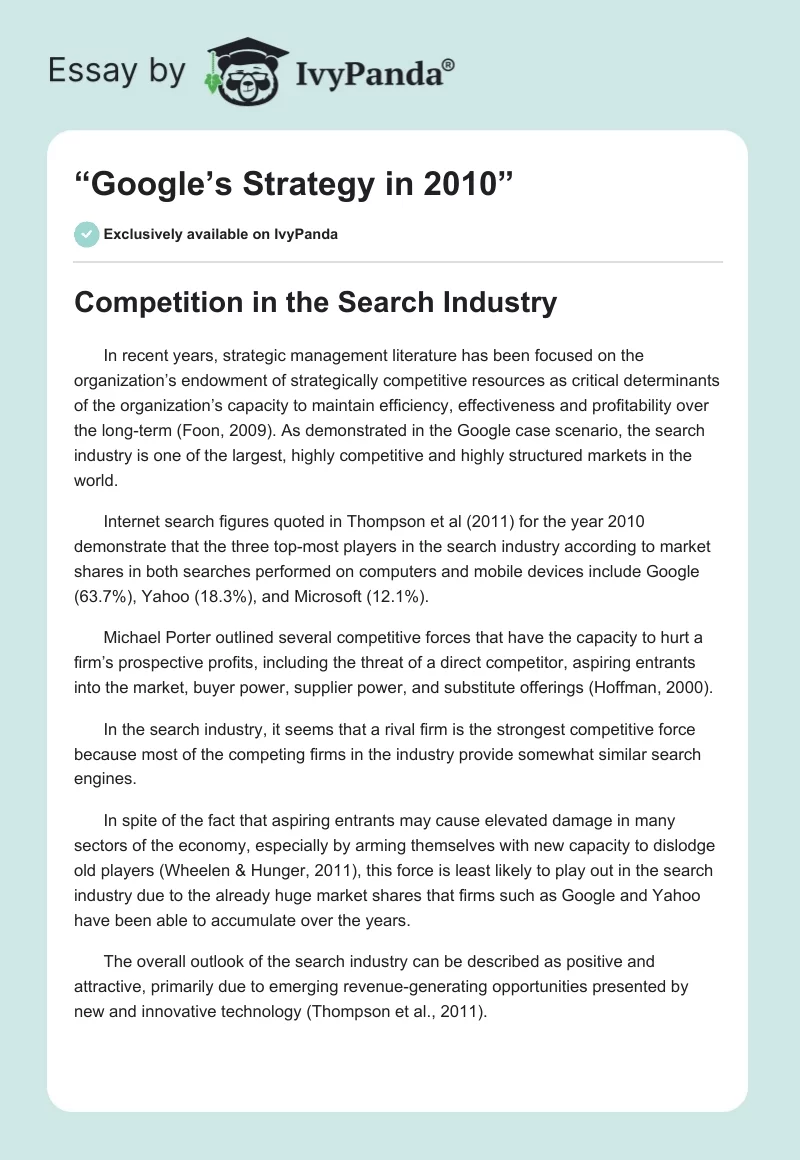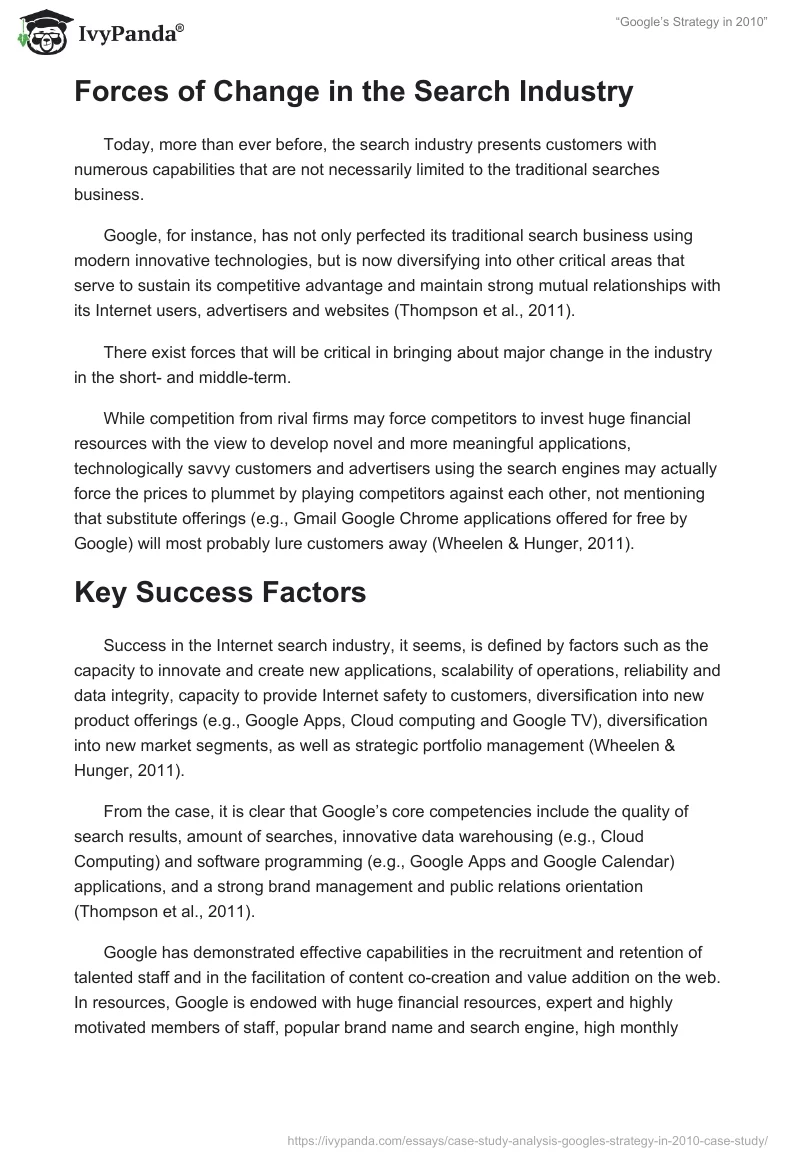Competition in the Search Industry
In recent years, strategic management literature has been focused on the organization’s endowment of strategically competitive resources as critical determinants of the organization’s capacity to maintain efficiency, effectiveness and profitability over the long-term (Foon, 2009). As demonstrated in the Google case scenario, the search industry is one of the largest, highly competitive and highly structured markets in the world.
Internet search figures quoted in Thompson et al (2011) for the year 2010 demonstrate that the three top-most players in the search industry according to market shares in both searches performed on computers and mobile devices include Google (63.7%), Yahoo (18.3%), and Microsoft (12.1%).
Michael Porter outlined several competitive forces that have the capacity to hurt a firm’s prospective profits, including the threat of a direct competitor, aspiring entrants into the market, buyer power, supplier power, and substitute offerings (Hoffman, 2000).
In the search industry, it seems that a rival firm is the strongest competitive force because most of the competing firms in the industry provide somewhat similar search engines.
In spite of the fact that aspiring entrants may cause elevated damage in many sectors of the economy, especially by arming themselves with new capacity to dislodge old players (Wheelen & Hunger, 2011), this force is least likely to play out in the search industry due to the already huge market shares that firms such as Google and Yahoo have been able to accumulate over the years.
The overall outlook of the search industry can be described as positive and attractive, primarily due to emerging revenue-generating opportunities presented by new and innovative technology (Thompson et al., 2011).
Forces of Change in the Search Industry
Today, more than ever before, the search industry presents customers with numerous capabilities that are not necessarily limited to the traditional searches business.
Google, for instance, has not only perfected its traditional search business using modern innovative technologies, but is now diversifying into other critical areas that serve to sustain its competitive advantage and maintain strong mutual relationships with its Internet users, advertisers and websites (Thompson et al., 2011).
There exist forces that will be critical in bringing about major change in the industry in the short- and middle-term.
While competition from rival firms may force competitors to invest huge financial resources with the view to develop novel and more meaningful applications, technologically savvy customers and advertisers using the search engines may actually force the prices to plummet by playing competitors against each other, not mentioning that substitute offerings (e.g., Gmail Google Chrome applications offered for free by Google) will most probably lure customers away (Wheelen & Hunger, 2011).
Key Success Factors
Success in the Internet search industry, it seems, is defined by factors such as the capacity to innovate and create new applications, scalability of operations, reliability and data integrity, capacity to provide Internet safety to customers, diversification into new product offerings (e.g., Google Apps, Cloud computing and Google TV), diversification into new market segments, as well as strategic portfolio management (Wheelen & Hunger, 2011).
From the case, it is clear that Google’s core competencies include the quality of search results, amount of searches, innovative data warehousing (e.g., Cloud Computing) and software programming (e.g., Google Apps and Google Calendar) applications, and a strong brand management and public relations orientation (Thompson et al., 2011).
Google has demonstrated effective capabilities in the recruitment and retention of talented staff and in the facilitation of content co-creation and value addition on the web. In resources, Google is endowed with huge financial resources, expert and highly motivated members of staff, popular brand name and search engine, high monthly turnover of online traffic, as well as deeply satisfied and loyal customers (Wheelen & Hunger, 2011).
Customer Value Proposition & Profit formula
Google views itself as an enterprise that is essentially concerned with delivering value to customers through open innovation strategies, research and development (R&D), and acquisition of smaller technologically-oriented firms to achieve flexibility and reduce costs associated with developing new products.
Google’s acquisition of YouTube, Postini, On2 and DoubleClick, for instance, not only meant that more knowledge became available for the firm to continuously innovate, but also implied that alternative technologies could be kept open for longer periods of time, and that it was now possible to convey the experience and benefits of their products (e.g., high-level video streaming and compression capabilities) to customers (Wheelen & Hunger, 2011).
Google’s cost-per-impression (CPI) and cost-per-tick (CPC) profit formulas, alongside its customer value-based propositions, have enabled the firm to excel in operational efficiency, customer intimacy and product leadership (Thompson et al., 2011).
Google’s Business Model & Strategy
By far, Google’s business model, which is premised on allowing advertisers to bid on search terms that would describe their CPI or CPC basis (Thompson et al., 2011), speaks volumes about the firm’s success in a highly competitive business environment. Google’s strategy for venturing into new product markets has seen the firm experience remarkable revenue growth in non-traditional search areas as evidenced by its financial statements.
Apart from this, it is clear that Google has opportunities for more growth, especially in mobile phone applications, cloud computing, Google Apps, and Google TV. These growth projections imply that investors should be impressed with the firm’s financial performance. The table below demonstrates how Google compares with other competitors (Yahoo and Microsoft) in the search industry.
Table 1: Selected Financial Disclosures
The figure above shows that Google had a net income of over $6 billion going into 2010, against its major competitors Yahoo ($597 million) and Microsoft (less than $15 million). A strong financial muscle forms a competitive advantage for Google, hence a strong indicator for investors that the firm is indeed headed in the right direction, at least competitively.
Google’s Key Resources & Competitive Capabilities
It is imperative to conduct a SWOT analysis to identify Google’s key resources, opportunities and competitive capabilities, as well as its competitive liabilities, weaknesses and threats to continued success. The results from the analysis are illustrated in the table below
Table 2: SWOT Analysis for Google
Recommendations for Practice
Although Google boasts a strong competitive position going into the future, it should consider investing more in R&D to stimulate creative and innovative practices. Additionally, the firm should continue searching and engaging in strategic alliances with other like-minded firms not only to promote open source standards, but also to achieve effective product integration and interoperability (Thompson et al., 2011).
It is also recommended that Google should continue diversifying its product offerings to open up more revenue streams. Lastly, the firm should consider investing in internet security applications to keep its customers loyal and satisfied.
References
Foon, L.S. (2009). Capabilities differentials as sources of sustainable competitive advantage. International Journal of Business & Society, 10(2), 20-38.
Hoffman, N.P. (2000). An examination of the “sustainable competitive advantage” concept: Past, present, and future. Academy of Marketing Science Review, 2000(4), 562-578.
Thompson, A., Peteraf, M., Gamble, J., & Strickland, A.J. (2011). Crafting and executing strategy: The quest for competitive advantage: Concept and cases (18th ed.). New York, NY: McGraw-Hill/Irwin.
Wheelen, T.L., & Hunger, J.D. (2011). Strategic management and business policy: Toward global sustainability (13th ed.). Upper Saddle River, NJ: Prentice Hall.


